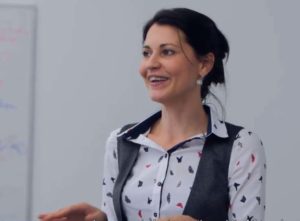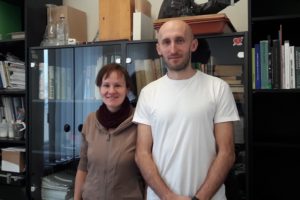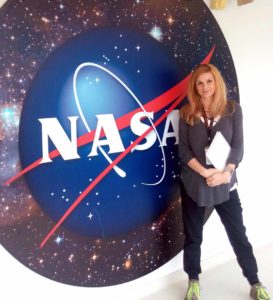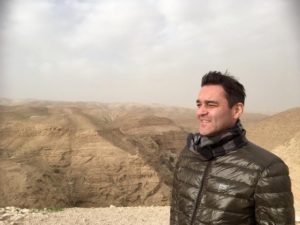Dear visitors,
on this page we would like to bring you stories or recommendations of our colleagues about the impact of appointment at the Institute on their professional carrier. We hope their words will be inspiring for our future colleagues.
Mariana Derzi
Position at IIC SAS: PhD student, 10/2002 – 09/2007, supervisor: Dr. Ľubomír Smrčok
Presently: Researcher fascinated by crystal structures at Advanced Technologies Research Institute Faculty of Materials Science and Technology in Trnava, Slovak University of Technology in Bratislava 
- My research focuses on atomic-scale modelling of crystals. My professional training started at the IIC SAS, where I did postgraduate studies in chemical physics and where I for the first time lied my hands on modelling of molecular and crystals structures. My research had also an experimental aspect involving X-ray and neutron diffraction and spectroscopic techniques and methods to study crystals with complex hydrogen bonds. The rich package of skills and knowledge that I gained at the Institute of Inorganic Chemistry played a key role in my future professional carrier. I was awarded one-year-long Marie Curie Skłodowska Early Research scholarship at Institute of Nuclear Physics in Cracow followed by prestigious four-year-long postgraduate scholarship at Warsaw University awarded by Foundation for Polish Science that I finalized by habilitation in physical sciences. My fascination by crystal structures started at IIC SAS and fully developed at Warsaw University where I focused on ab initio prediction and characterization of novel functional compounds. I am now continuing the fantastic journey into what fascinates me the most – crystal networks, polymorphism and structural phase transitions – at the Advanced Technologies Research Institute in Trnava, where I focus on predicting new materials for future electronics and spintronics.
Monika Michálková
Period of stay at the Institute and position: 2006 – 2009 PhD. student, since 2009 researcher
Actual position: researcher
- Q1: Are there any connections between the activities at IIC SAS and your recent position?
I am still employee of IIC SAS, however during my PhD. study I spend half a year at Empa Swiss Federal Laboratories for Material Science and Technology and as a PostDoc I had the possibility to spend one year in Germany at the University of Applied Science in Muenster and half a year in Switzerland at Empa. Good collaboration later on resulted in another 2 years project with Switzerland on which I participated.
- Q2: Please comment your relation to your stay at IIC SAS?
I greatly appreciate the opportunity to work with colleagues at IIC SAS. During my stay, they gave me many valuable comments and suggestion that helped to improve my knowledge and laboratory skills. PhD. study at the IIC SAS gave me a broad background in the field of preparation and testing of ceramic. The IIC SAS is very well equipped with new machines which was very useful also during my stay in abroad.

Martin Michálek
Period of stay at the Institute and position: 2009 – 2013 PhD. student, since 2013 researcher
Actual position: FunGlass – Centre for Functional and Surface Functionalized Glass, Alexander Dubček University of Trenčín
Previous position: Empa, Switzerland, High performance ceramic department
- Q1: Are there any connections between the activities at IIC SAS and your recent position?
At my recent position I am just the second month. Nevertheless, there was, is and will be a strong collaboration between my current institute and the IIC SAS. Myself I am still in contact with many of my previous co-workers. Not only professional but also personal. I keep in mind that the IIC SAS are well equipped, and on demand they can offer a help with measurements, experiments and advice in professional manner. It was during my stay at Empa and I am pretty sure that it will be in the future too.
- Q2: Please comment your relation to your stay at IIC SAS?
At IIC SAS I stayed during my PhD. study, except 1.5 Year, which I was at the University of Muenster in Germany. I have to say that every employee was helpful and participated on my career and development. The gained knowledge I utilized mostly at Empa, Switzerland, where the first 2 Years I was as a postdoc and stayed there for another 2 years as a researcher. What means that the acquired professional skills at IIC SAS are really helpful.
- Q3: Can you give some recommendations to the management of IIC SAS?
The management of IIC SAS should improve the advertisement of the academy. The opportunity of studying diverse materials and be by the breakthrough discoveries should be the main advantage for the young people to go there. Moreover, the chance of get in touch with many different cultures, peoples and visit interesting places is a great benefit too. The applicants should know these.
Slávka Carvalho Andrejkovičová
Period of stay at the Institute and position: 09/2003 – 03/2008 PhD. student, supervisor Dr. Peter Komadel, since finishing thesis employed as researcher
Actual position: Research scientist at NASA Godard space flight center, Greenbelt, Maryland and a Visiting Assistant Research Scientist at Univesity of Maryland College Park. I am a team member on the Sample Analysis at Mars (SAM) Instrument Suite, one of the instruments on Curiosity rover.
- I am a chemist/clay mineralogist with a research focus on the mineralogy and chemistry of martian samples and their analogs and in general I specialize in synthesis/analysis of terrestrial Mars analog materials that are directly relevant to interpreting MSL (Mars Science Laboratory, more known as Curiosity) flight data. Recently, I am investigating the possibility of reduced nitrogen reservoirs on Mars. The potential detection of reduced N compounds on Mars has important implications for the development of a nitrogen cycle on Mars, and therefore Mars’ potential habitability. My focus is on preparation of clay minerals with NH4+ cations in the interlayer space which are characterized with a variety of analytical techniques, such X-ray diffraction analysis (XRD), Evolved Gas Analysis (EGA), FTIR (Fourier Transform Infrared) ATR, Elemental Analysis (EA), Gas Chromatography Mass Spectrometry (GCMS) etc., which are later compared to the real flight data. At this point is very important to mention that all my detailed knowledge I gained about clay minerals and their characterization by various methods was during my PhD. study at IIC SAS. My PhD. supervisor Dr. Peter Komadel and Dr. Jana Madejová are recognized capacities in the field of clay minerals and Slovak clay group has a very strong reputation worldwide, thus I got really solid background, which I am using up to this day.
Daniel Tunega
Period of stay at the Institute and position: 1984-1988 Research Assistant, 1988-1991 Doctoral study on molecular modeling of layer silicates under supervision of Dr. Dalma Gyepesova, 1993-1994 Research Assistant, 1994 Defense of doctoral thesis, 1995-1997 Research Scientist, 1997-1998 Senior Research Scientist
In 1998 I leaved IIC getting for a postdoc position at Austrian Institute for Technology (AIT) in Austria
Previous positions: 1998-2006 Postdoc positions at AIT, Institute for Theoretical Chemistry, Univ. Vienna, and Inst. for Soil Research (Inst. fur Bodenforschung, IBF), University of Natural Resources and Life Sciences (Bodenkultur Univesitat, BOKU, Wien),
Actual position: Since 2007 permanent position as the Senior Scientist at IBF BOKU
- Q1: Are there any connections between the activities at IIC SAS and your recent position?
The connections between activities at IIC and my recent position are very active. The Department of Theoretical Chemistry and the Department of Hydrosilicates are focused on the research of organoclay materials, which is also one of the topics of my research activities. I actively collaborate with both IIC departments.
- Q2: Please comment your relation to your stay at IIC SAS?
I appreciate much the beginning years of my scientific carrier including the PhD study that I spent in the Spectroscopy Laboratory later renamed on the Department of Theoretical Chemistry. I found there a very friendly environment where I could growth professionally and also personally. The collaborations with colleagues from IIC are focused on modeling of various materials including organoclays and during the long-standing collaboration we published about 20 joint publications.
- Q3: Can you give some recommendations to the management of IIC SAS?
Maybe the management of the Institute should focus more intensively on seeking young talented students at universities because I have a feeling that it is more and more difficult to hire really good students for PhD positions. This also could include seeking students from abroad (generally).
Michal Korenko
Position at IIC SAS: Senior research fellow 2003 – present, Department of Molten Systems.
High temperature chemistry and electrochemistry of molten systems, with emphasis on molten halides. Study of relations between the composition, the properties and the structure of inorganic melts, electrolytes and solid materials.
- Postdoctoral Position: Valparaiso University, Indiana, USA (Mar 2014 – Dec 2016)
Solar thermal electrolysis of MgO from molten fluorides
The project was oriented towards an eco–economic way of solar–thermal electrochemical industrial production of Mg from molten fluorides. The project was funded by US Department of Energy (DOE). The process was based on a solar–thermal electrolysis of MgO from molten salts. We used the molten fluoride electrolyte and molten sodium as solar heat transfer medium. The principal investigator was Valparaiso University in Indiana with an extended network of partners like Chrysler, Navigant, Solar Diver and Purdue University. The project was supervised by the Advanced Research Projects Agency–Energy (http://arpa-e.energy.gov/). The ultimate goal was to develop an industrially viable, economically competitive and ecologically friendly process of Mg electrolytic production at high temperatures with the utilization of concentrated solar heat. The responsible investigator was Professor Robert Palumbo and the technology generated by this project was patented in USA. More about the project can be found here: https://www.youtube.com/watch?time_continue=161&v=HWo6_MhaDdo
- Postdoctoral Position: Nuclear Research Institute Rež, Czech Republic (Jan 2009 – Feb 2011)
EUROATOM FP7 project (ACtinide recycling by SEParation and Transmutation) and several projects for national radioactive waste and repository authority of the Czech Republic (SURAO).
Electrochemical separation of actinides and lathanides in molten fluorides
The work at NRI was focused on developing a pyrochemical electrochemical techniques for separation of lanthanides and actinides from nuclear waste materials. This topic was directly related with the national and EU effort to build an electrochemical separation unit for the nuclear reactors based on molten salts (MSR). A high temperature corrosion testing loop had been also there developed for dynamic tests of different construction materials for the MSR heat delivery technology.
 Kontakt
Kontakt Intranet
Intranet EN
EN

